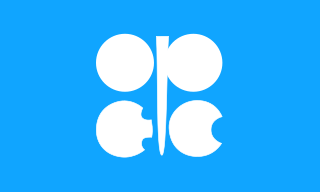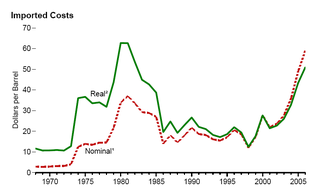Related Research Articles

The history of the petroleum industry in the United States goes back to the early 19th century, although the indigenous peoples, like many ancient societies, have used petroleum seeps since prehistoric times; where found, these seeps signaled the growth of the industry from the earliest discoveries to the more recent.

Petroleum, also known as crude oil and oil, is a naturally occurring, yellowish-black liquid found in geological formations beneath the Earth's surface. It is commonly refined into various types of fuels. Components of petroleum are separated using a technique called fractional distillation, i.e. separation of a liquid mixture into fractions differing in boiling point by means of distillation, typically using a fractionating column. It consists of naturally occurring hydrocarbons of various molecular weights and may contain miscellaneous organic compounds. The name petroleum covers both naturally occurring unprocessed crude oil and petroleum products that are made up of refined crude oil. A fossil fuel, petroleum is formed when large quantities of dead organisms, mostly zooplankton and algae, are buried underneath sedimentary rock and subjected to both intense heat and pressure.

The Organization of the Petroleum Exporting Countries is an intergovernmental organization of 13 countries. Founded on 14 September 1960 in Baghdad by the first five members, it has since 1965 been headquartered in Vienna, Austria, although Austria is not an OPEC member state. As of September 2018, the 13 member countries accounted for an estimated 44 percent of global oil production and 81.5 percent of the world's "proven" oil reserves, giving OPEC a major influence on global oil prices that were previously determined by the so-called "Seven Sisters" grouping of multinational oil companies. A larger group called OPEC+ was formed in late 2016, to have more control on global crude oil market. The demand for OPEC oil has fallen to a 30-year low in the second quarter of 2020.
The Strategic Petroleum Reserve (SPR) is a supply of petroleum held by the United States Department of Energy (DOE) for emergency fuel. It is the largest emergency supply in the world, and its underground tanks in Louisiana and Texas have capacity for 797 million barrels (126,700,000 m3). The United States started the petroleum reserve in 1975 after oil supplies were interrupted during the 1973–1974 oil embargo, to mitigate future supply disruptions.
The 1973 oil crisis began in October 1973 when the members of the Organization of Arab Petroleum Exporting Countries proclaimed an oil embargo. The embargo was targeted at nations perceived as supporting Israel during the Yom Kippur War. The initial nations targeted were Canada, Japan, the Netherlands, the United Kingdom and the United States with the embargo also later extended to Portugal, Rhodesia and South Africa. By the end of the embargo in March 1974, the price of oil had risen nearly 300%, from US$3 per barrel to nearly $12 globally; US prices were significantly higher. The embargo caused an oil crisis, or "shock", with many short- and long-term effects on global politics and the global economy. It was later called the "first oil shock", followed by the 1979 oil crisis, termed the "second oil shock".
The National Energy Program (NEP) was an energy policy of the Canadian federal government from 1980 to 1985. Created under the Liberal government of Prime Minister Pierre Trudeau by Energy Minister Marc Lalonde in 1980, the program was administered by the Department of Energy, Mines and Resources. Introduced following the oil crises and stagflation of the 1970s, the NEP proved to be a highly controversial policy initiative that pitted economic nationalism and federal aspirations of energy self-sufficiency against provincial jurisdiction with hundreds of billions of dollars in oil revenue at stake. The result was a dispute that sparked intense opposition and anger in Canada's West, particularly in Alberta, and the rise of the Reform Party, a development that would shape Canadian politics for years to come.

The energy policy of the United States is determined by federal, state, and local entities in the United States, which address issues of energy production, distribution, and consumption, such as building codes and gas mileage standards. Energy policy may include legislation, international treaties, subsidies and incentives to investment, guidelines for energy conservation, taxation and other public policy techniques.

The Energy Policy and Conservation Act of 1975 (EPCA) is a United States Act of Congress that responded to the 1973 oil crisis by creating a comprehensive approach to federal energy policy. The primary goals of EPCA are to increase energy production and supply, reduce energy demand, provide energy efficiency, and give the executive branch additional powers to respond to disruptions in energy supply. Most notably, EPCA established the Strategic Petroleum Reserve, the Energy Conservation Program for Consumer Products, and Corporate Average Fuel Economy regulations.

The Ministry of Petroleum (MOP) (Persian: وزارت نفت Vezârat-e Naft) manages the oil industry, the producer of oil and petrochemical products. MoP is in charge of all issues pertaining to exploration, extraction, exploitation, distribution and exportation of crude oil and oil products. In addition, according to the "Imports and Exports Regulation Act", issuing import licenses for such products is also among the functions of the Ministry of Petroleum. According to BP, Iran's has 137.6 billion barrels (2.188×1010 m3) of proven oil reserves and 29.61 trillion cubic meters of proven gas reserves. Iran ranks third in the world in oil reserves and second in gas reserves. It is responsible for applying the principle of Iranian ownership and sovereignty over oil and gas reserves. Also, it is undertake the separation of sovereignty tasks from management and development of country's oil and gas industry.

US energy independence is the idea of eliminating the need for the United States to import petroleum and other foreign sources of energy. Energy independence is espoused by those who want to leave the US unaffected by global energy supply disruptions, and to restrict reliance upon politically unstable states for its energy security. Energy independence is highly concerned with oil, the source of the country's principal transport fuels.

The 1980s oil glut was a serious surplus of crude oil caused by falling demand following the 1970s energy crisis. The world price of oil had peaked in 1980 at over US$35 per barrel ; it fell in 1986 from $27 to below $10. The glut began in the early 1980s as a result of slowed economic activity in industrial countries due to the crises of the 1970s, especially in 1973 and 1979, and the energy conservation spurred by high fuel prices. The inflation-adjusted real 2004 dollar value of oil fell from an average of $78.2 in 1981 to an average of $26.8 per barrel in 1986.

Venezuela is one of the world's largest exporters of oil and has the world's largest proven oil reserves at an estimated 296.5 billion barrels as of 2012.

The impact of the petroleum industry in China has been increasing globally as China ranks seventh for oil production and second in crude oil consumption in the world.

Petroleum in the United States has been a major industry since shortly after the oil discovery in the Oil Creek area of Titusville, Pennsylvania in 1859. The industry includes exploration, production, processing (refining), transportation, and marketing of natural gas and petroleum products. As of 2019, the United States is the world's largest oil producer. The leading oil-producing area in the United States in 2014 was Texas, followed by the offshore federal zone of the Gulf of Mexico, North Dakota and California.
Sources include: Dow Jones (DJ), New York Times (NYT), Wall Street Journal (WSJ), and the Washington Post (WP).
A production quota is a goal for the production of a good. It is typically set by a government or an organization, and can be applied to an individual worker, firm, industry or country. Quotas can be set high to encourage production, or can be used to restrict production to support a certain price level.
References
- ↑ Charles J. Cicchetti, Willian J. Gillen (July 1973). "The Mandatory Oil Import Quote Program: A Consideration of Economic Efficiency and Equity". Natural Resources Journal.
- ↑ "Proclamation 3279: Adjusting imports of petroleum and petroleum products into the United States". The Code of Federal Regulations of the United States of America. January 1, 1966.
crude oil and the principal crude oil derivatives and products are being imported in such quantities and under such circumstances as to threaten to impair the national security
- ↑ Yergin, Daniel (1992). "1959 U.S. Quota on Foreign Oil Imports". County of Santa Barbara. County of Santa Barbara. Retrieved 17 Feb 2015.